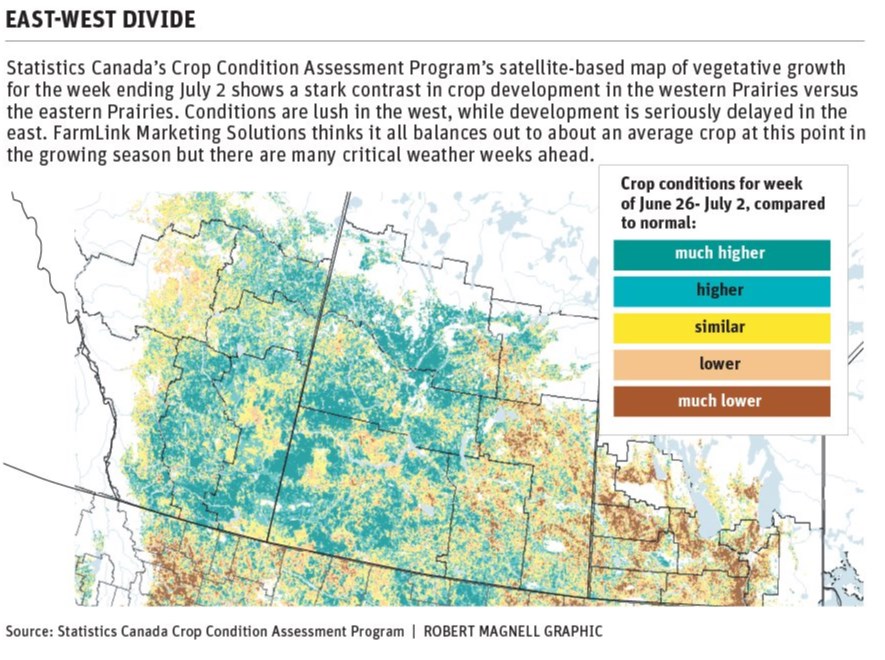WESTERN PRODUCER — Statistics Canada’s satellite-based vegetative growth map for the Canadian Prairies paints a picture with lots of green in the west and plenty of brown in the east.
Green means higher than normal vegetative growth. Brown means lower than normal. The dividing line is north and south of Regina.
The upshot is that the prairie region is likely looking at an average crop halfway through the growing season, said Neil Townsend, chief market analyst with FarmLink Marketing Solutions.
The previous five-year average for canola yields is 41.6 bushels per acre, excluding last year’s disastrous crop of 25 bu. per acre.
Townsend thinks that sounds about right for this year’s crop. Trend line yields would be closer to 43 to
“We’re not quite at trend but if this benevolent weather continues throughout the next couple of weeks of July, we’ll probably start to edge it up towards more of a trend yield,” he said.
Trevor Hadwen, agroclimate specialist with Agriculture Canada, said the brown stain on the map of the eastern Prairies for the week ending July 2 has more to do with planting delays than poor vegetative growth.
“The excess moisture in the eastern Prairies has caused some delays and some challenges in terms of green-up and plant production for the first part of the growing season,” he said.
There is a large area around Manitoba’s Red River Valley and north of Brandon where flooding and
There are also challenges in Saskatchewan around Wynyard and in the southeast corner of the province.
The good news is that when he looks at a week-by-week comparison of vegetative growth there has been “tremendous improvement” for much of the Prairie region, except for southwest Saskatchewan.
“That’s a really good sign,” said Hadwen.
It is encouraging to see improvements in vegetative growth heading into July because that is often not the case when conditions are excessively dry.
“I’m fairly optimistic actually in terms of how the conditions could improve for the end of the season,” he said.
Hadwen has heard from farmers across the Prairie region that heat units are about two weeks behind normal but there has been some hot weather of late and it is still early in the growing season.
“There’s still lots of time to catch up,” he said.
Townsend agrees with that sentiment. He said the crops in the east will either need an open window in the fall or more heat units to catch up.
Crop development west of Regina is much better than it is in the east.
“We’re seeing large amounts of above normal growth,” said Hadwen.
There are patches of dry areas around Rosetown, Sask. and in pockets of Alberta, such as Red Deer but nothing significant.
However, he noted that the western Prairies will need continued rainfall in July and August.
“Those areas are still vulnerable to moving into drought because they were so dry last year,” he said.
Townsend has spoken to farmers in the west who are still plenty nervous about crop prospects due to recent experience.
“Talking with them, they’re not prepared to say above average yet,” he said.
But he noted that conditions in southern Alberta are markedly improved from the past couple of years and yields in that region could offset any disappointing results in areas of Saskatchewan and Manitoba.
Hadwen said pests and disease are going to be a big problem this year right across the Prairies.
“We’re dealing with a lot of flea beetle damage, a lot of grasshopper damage and another one is big gopher problems in the central Prairies,” he said.
Grasshopper populations were on the rise in southern Alberta last year and early spring was nice and dry for their hatch period.
Excess moisture is a breeding ground for diseases like molds and rusts in the eastern Prairies where spraying has been hampered by continued rainfall and high humidity.
But in general, crop development is looking pretty good across the Prairies. A graphic that accompanies the map shows that the overall Prairie crop started out poor and delayed but had caught up by about week 19 and is now well ahead of normal development.
“We’re in a very good place right now,” said Hadwen.
Townsend agrees. He said there is no big disaster looming in either the east or the west, although he noted that there are still three to five weeks of critical weather ahead.





